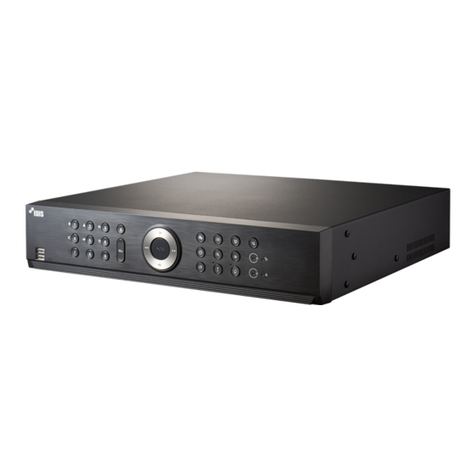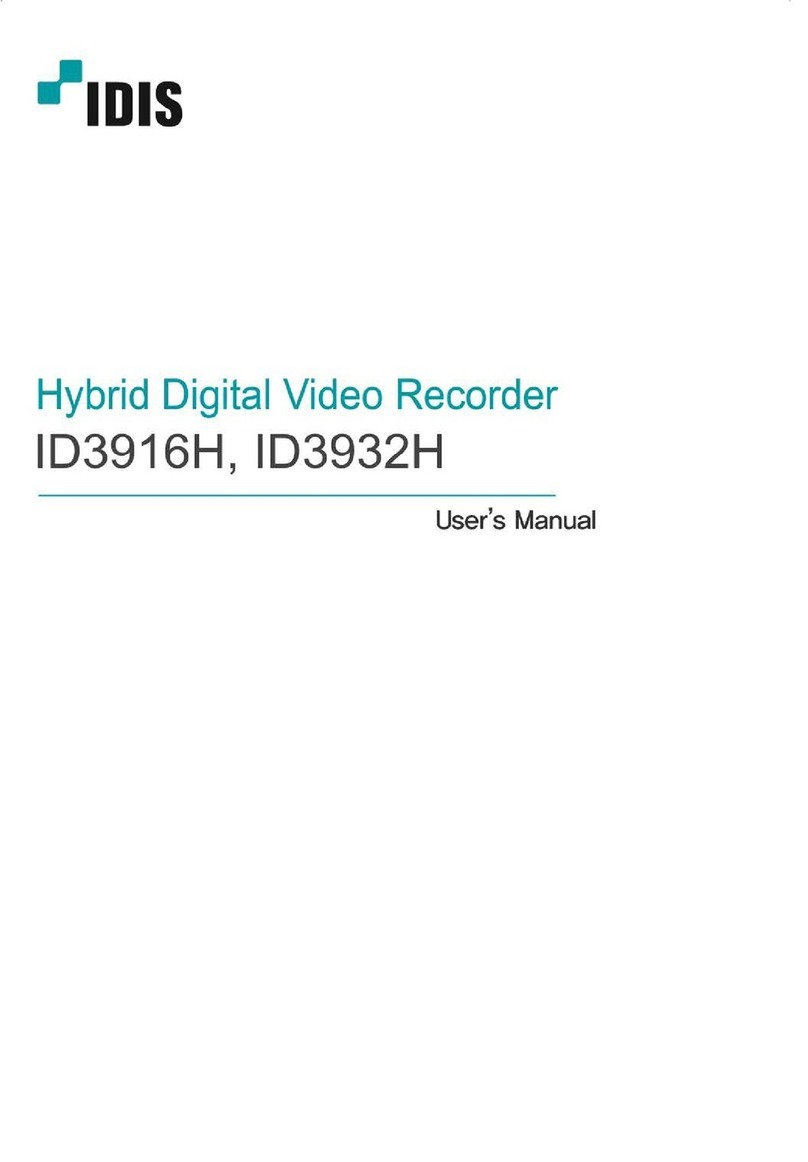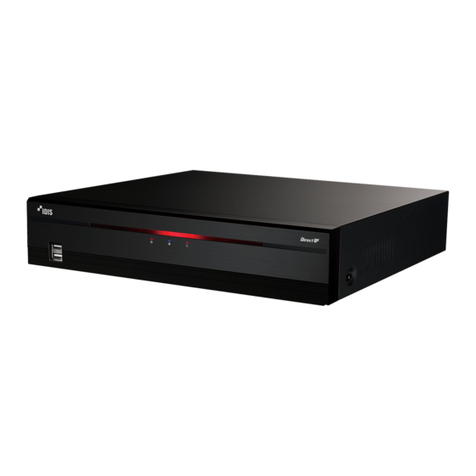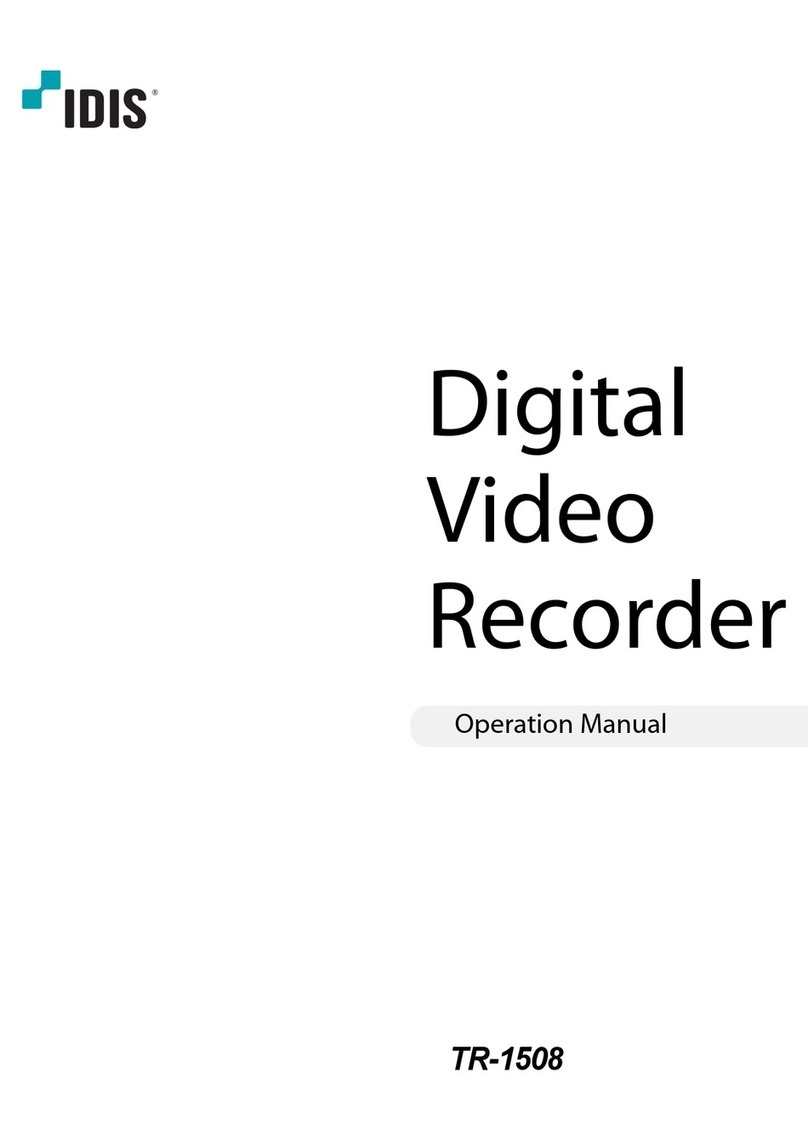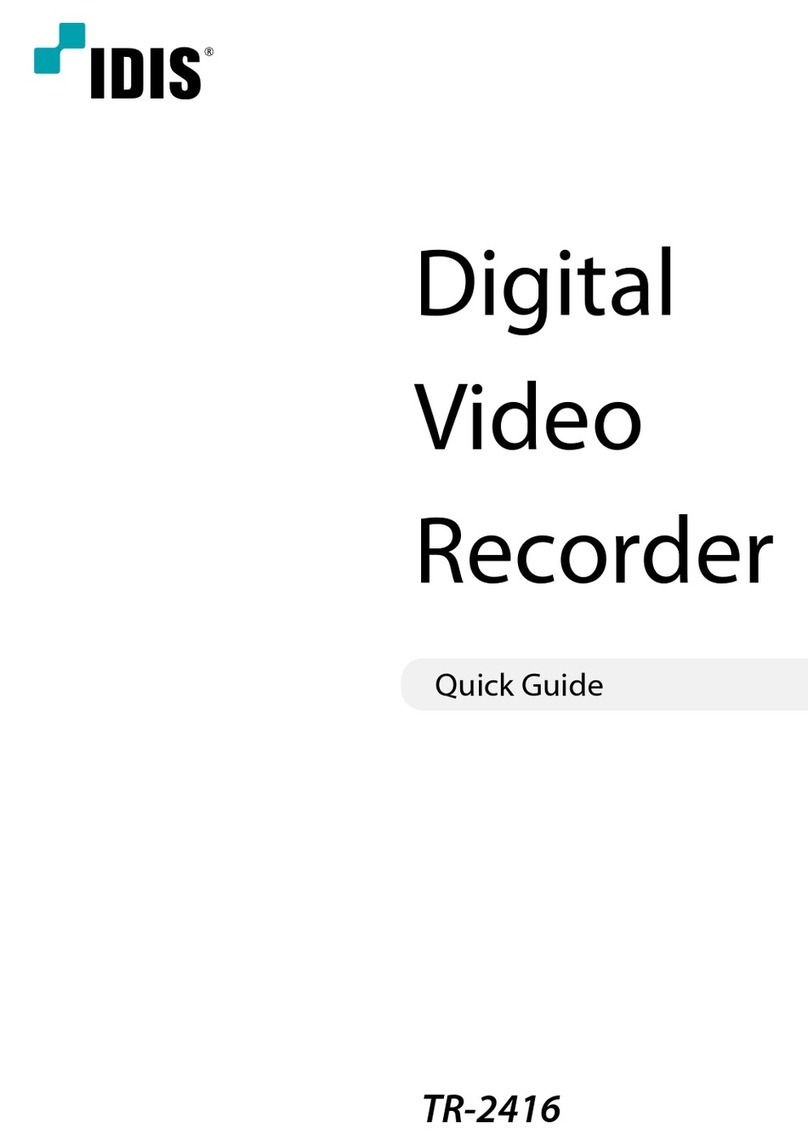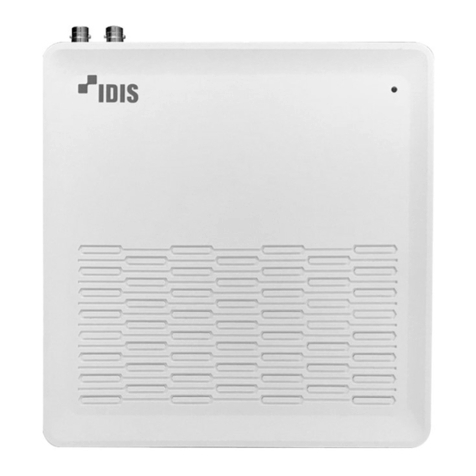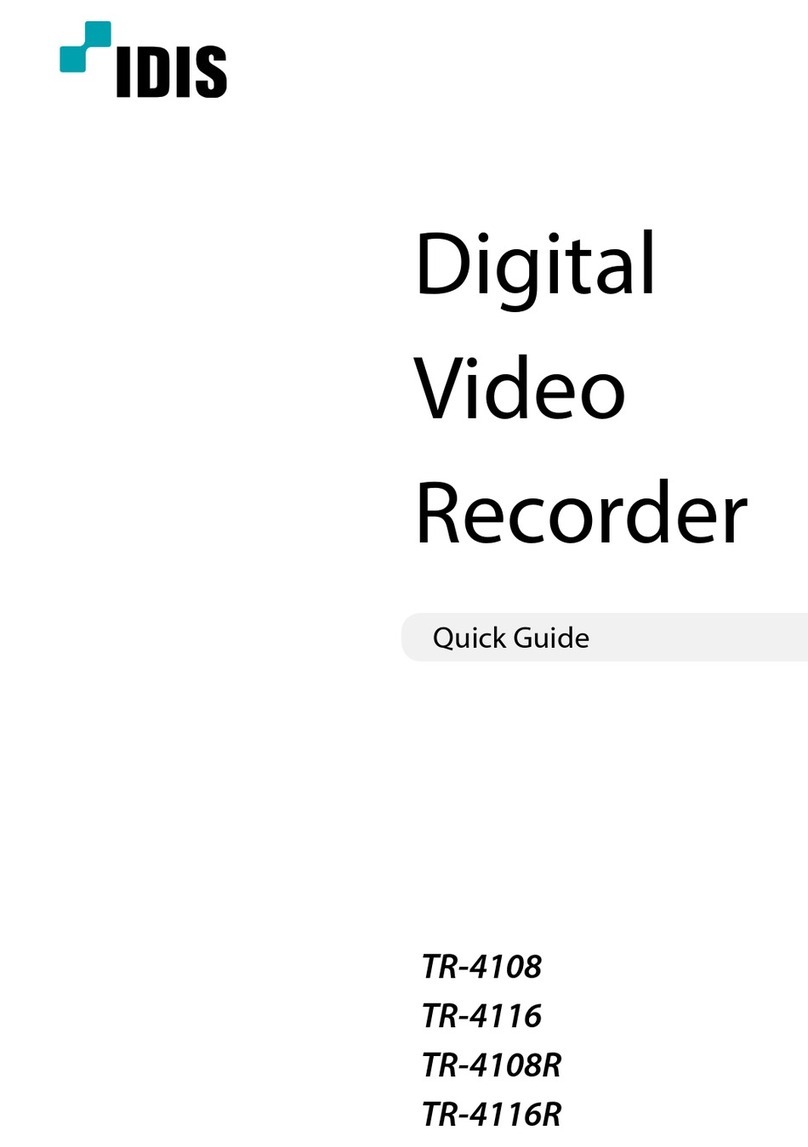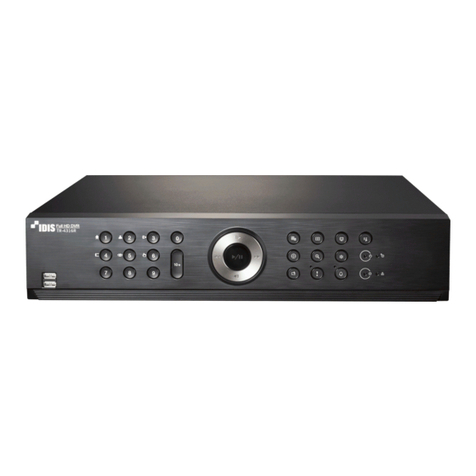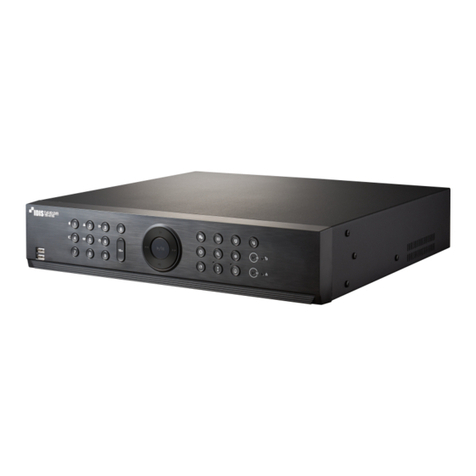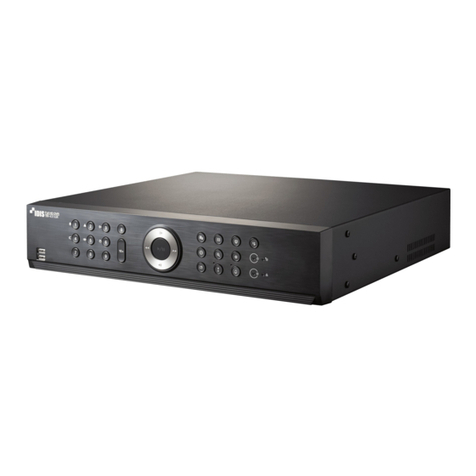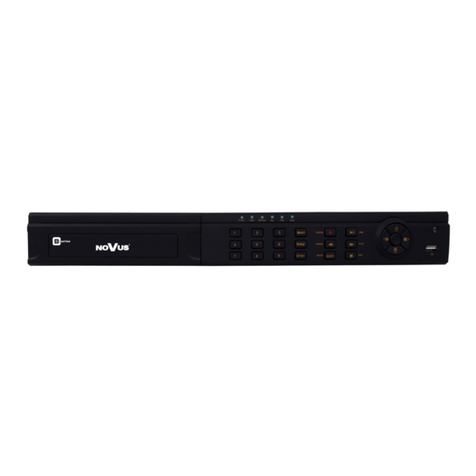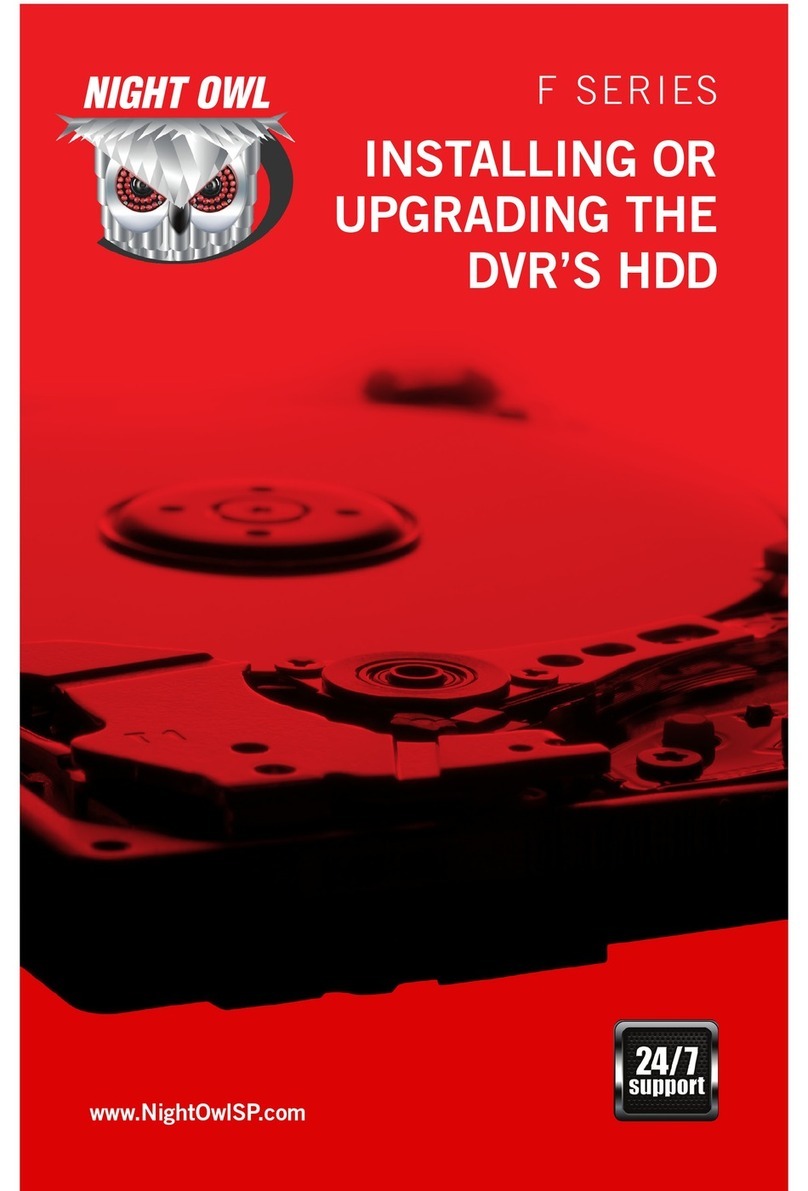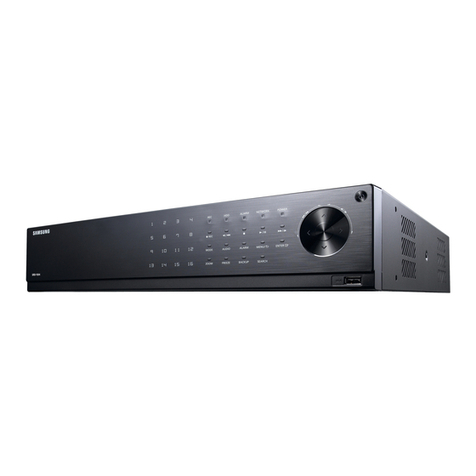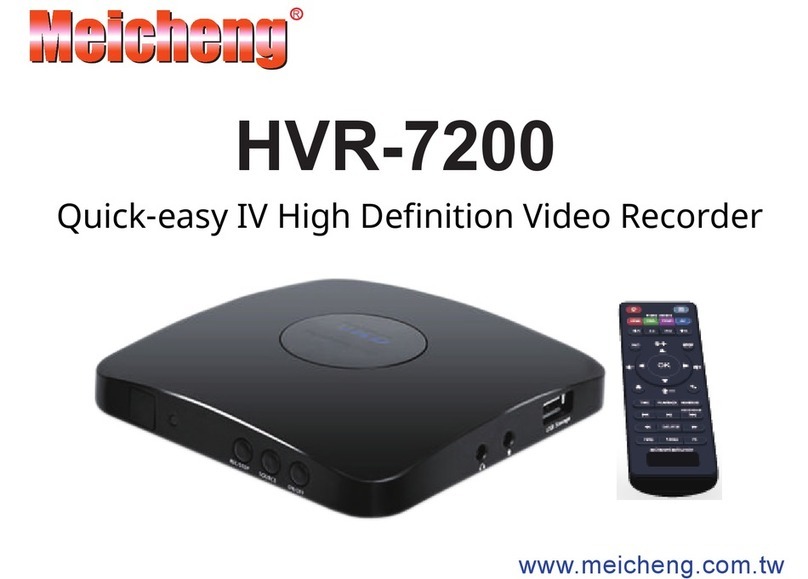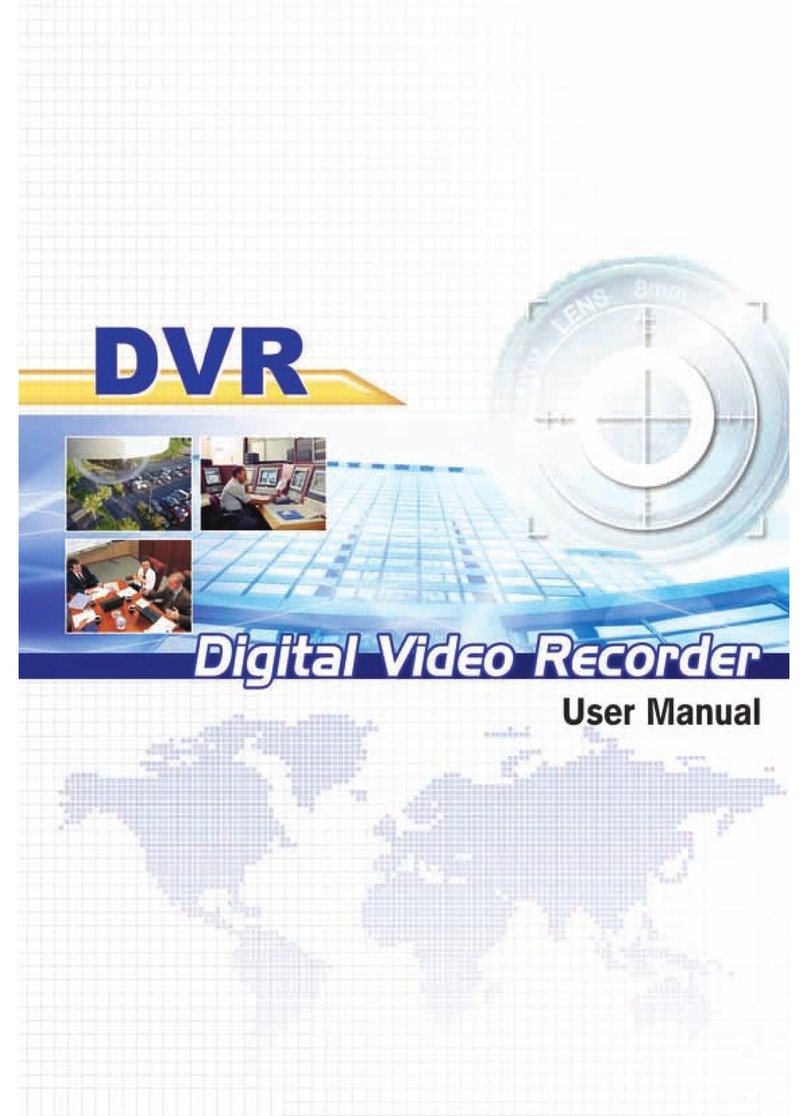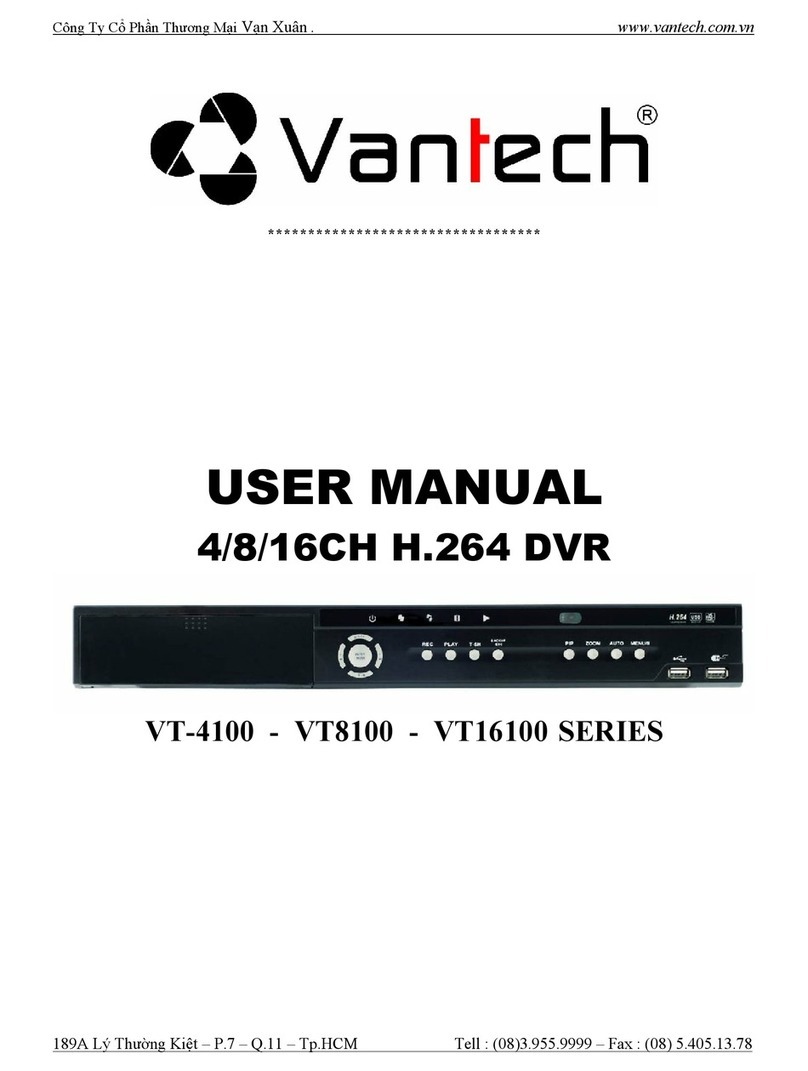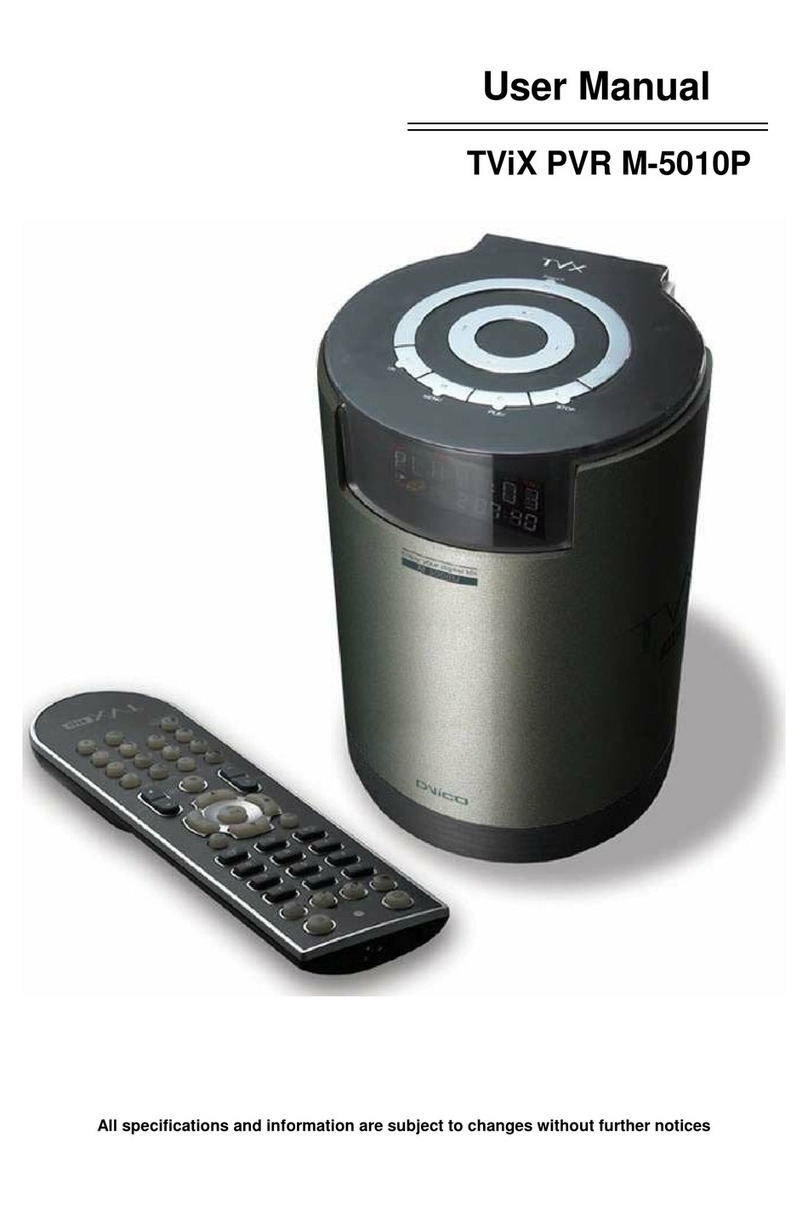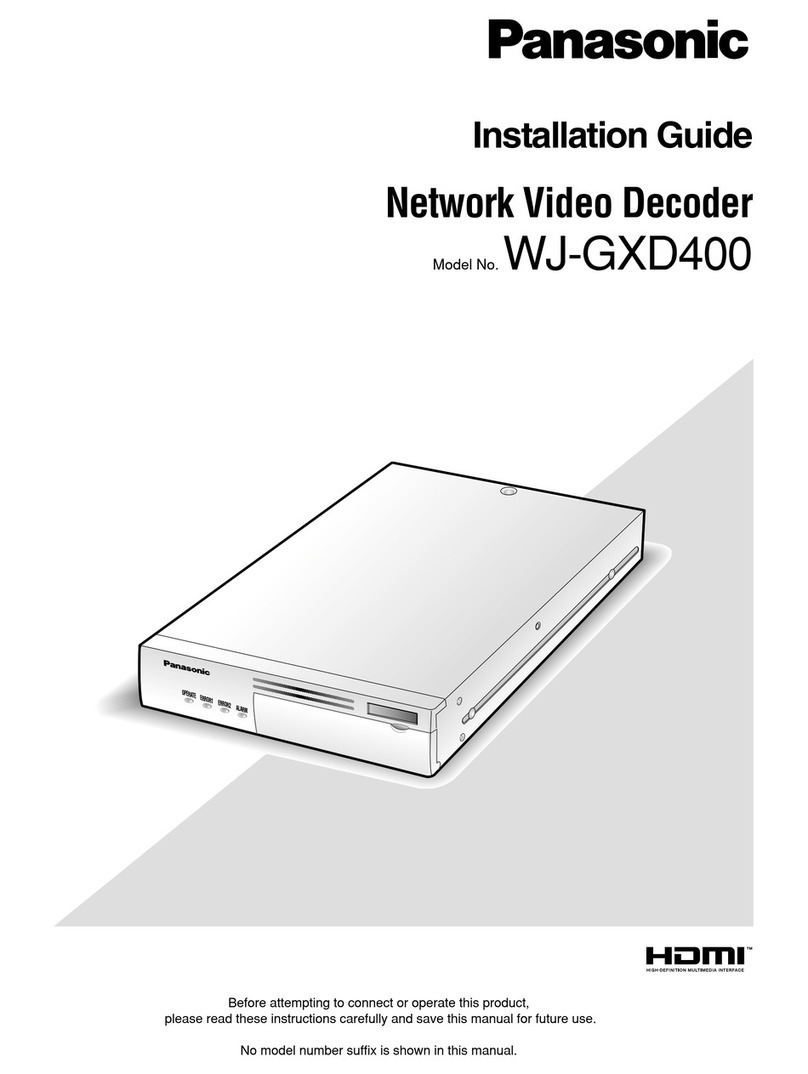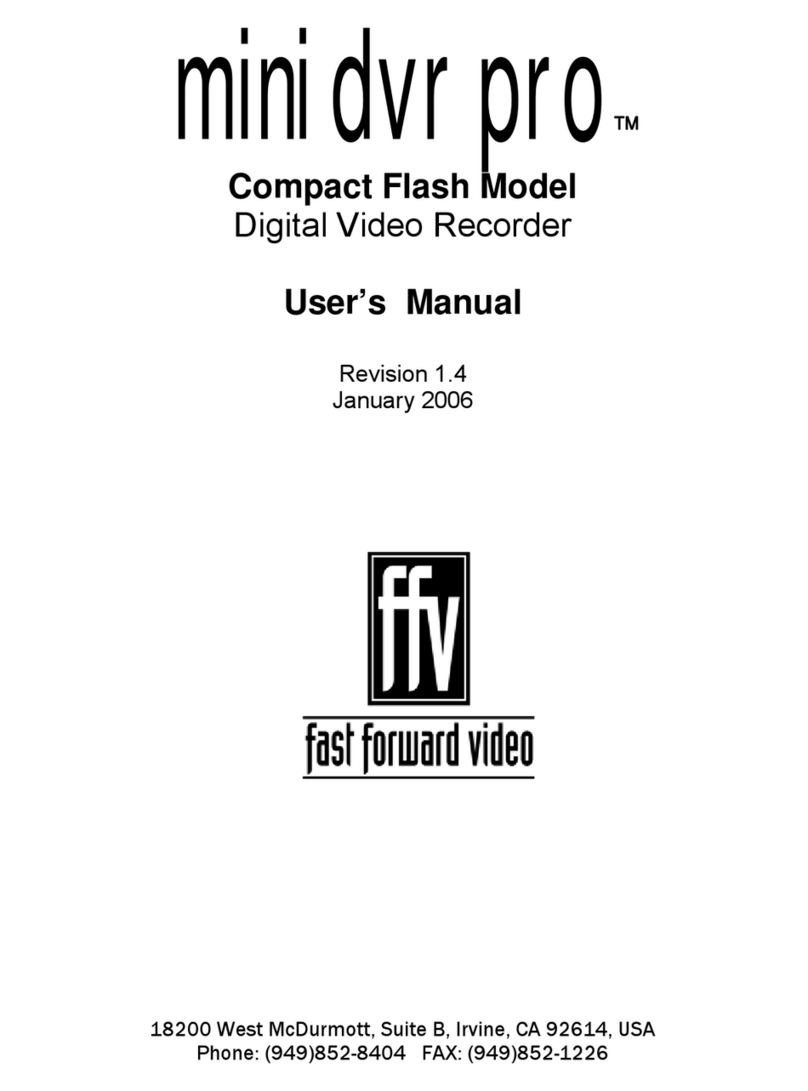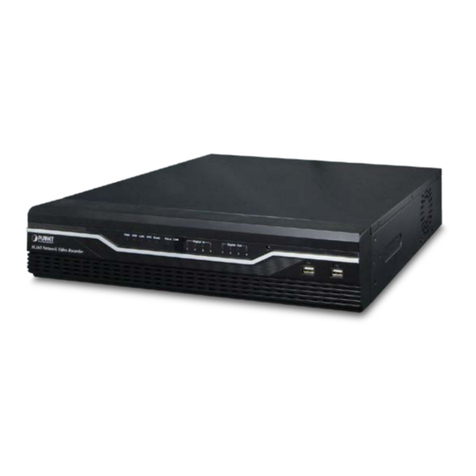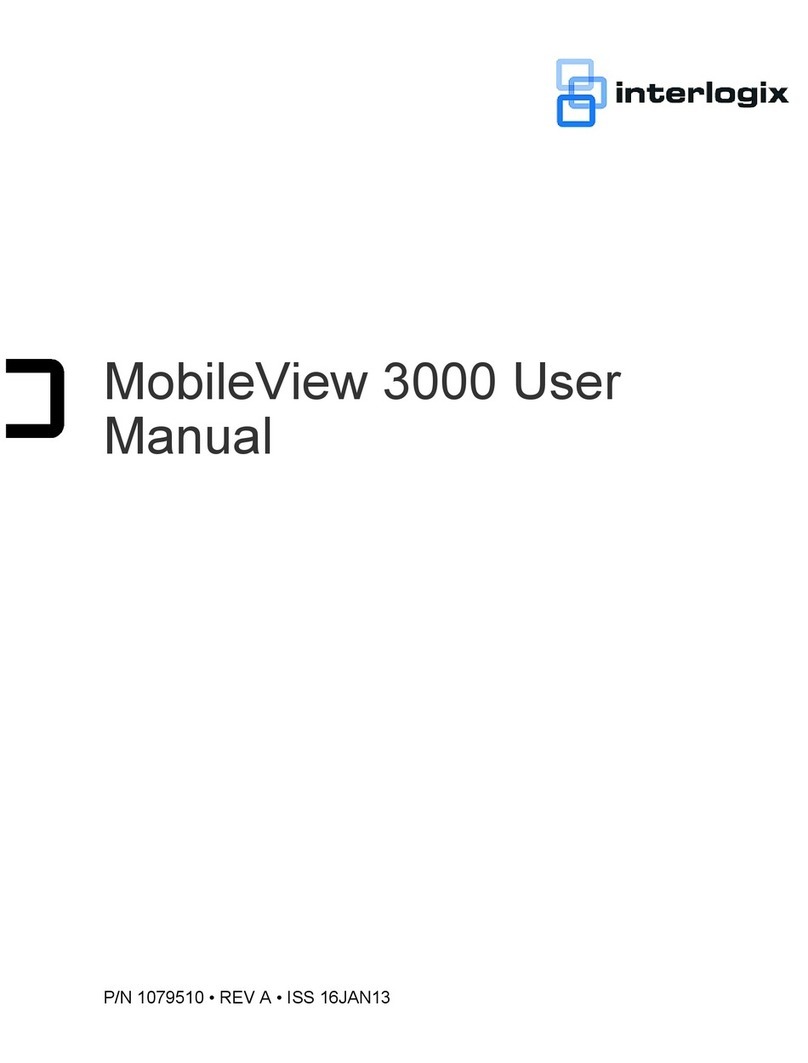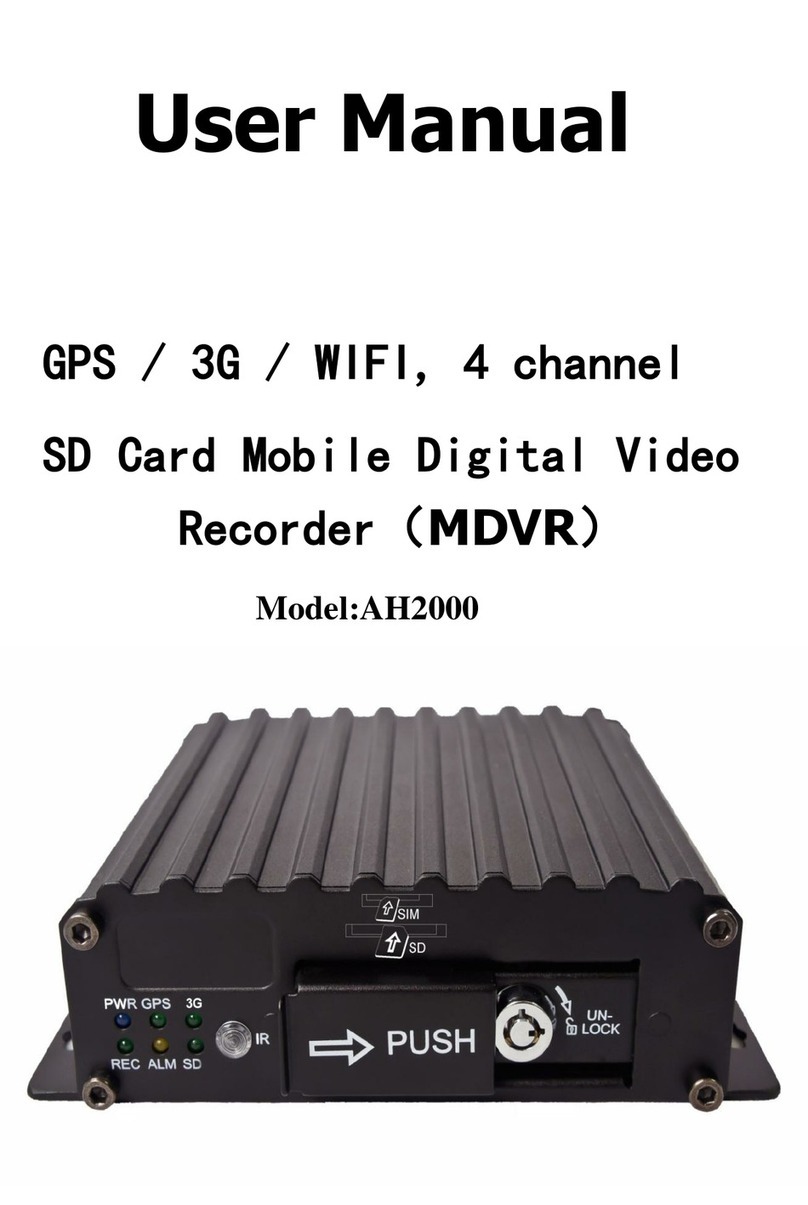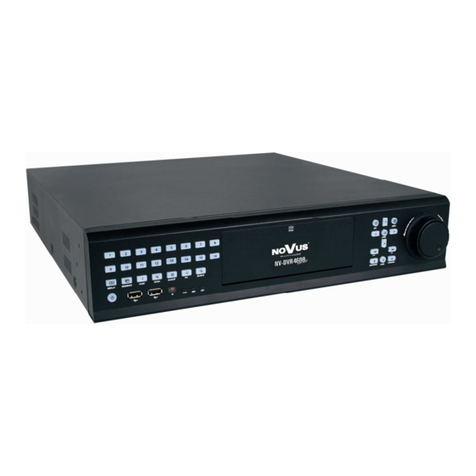Idis TR-2508 User manual

Digital
Video
Recorder
Operation Manual
TR-2504

2
This operation manual contains basic instructions on installing and using Digital Video Recorder, an IDIS product.
Users who are using this product for the rst time, as well as users with experience using comparable products, must
read this operation manual carefully before use and heed to the warnings and precautions contained herein while
using the product. Safety warnings and precautions contained in this operation manual are intended to promote
proper use of the product and thereby prevent accidents and property damage and must be followed at all times.
Once you have read this operation manual, keep it at an easily accessible location for future reference.
• The manufacturer will not be held responsible for any product damage resulting from the use of unauthorized parts and
accessories or from the user's failure to comply with the instructions contained in this operation manual.
• It is recommended that rst-time users of Digital Video Recorder and individuals who are not familiar with its use seek
technical assistance from their retailer regarding product installation and use.
• If you need to disassemble the product for functionality expansion or repair purposes, you must contact your retailer and
seek professional assistance.
• Both retailers and users should be aware that this product has been certied as being electromagnetically compatible for
commercial use. If you have sold or purchased this product unintentionally, please replace with a consumer version.
RISK OF ELECTRIC SHOCK
DO NOT OPEN
: TO REDUCE THE RISK OF ELECTRIC SHOCK,
DO NOT REMOVE COVER (OR BACK).
NO USER-SERVICEABLE PARTS INSIDE.
REFER SERVICING TO QUALIFIED SERVICE PERSONNEL.
The lightning ash with arrowhead symbol, within an equilateral triangle, is intended to alert the user to the
presence of uninsulated "dangerous voltage" within the product’s enclosure that may be of sucient magnitude to
constitute a risk of electric shock.
The exclamation point within an equilateral triangle is intended to alert the user to the presence of important
operating and maintenance (servicing) instructions in the literature accompanying the appliance.

Before reading this manual
3
Important Safeguards
All the safety and operating instructions should be read before the appliance
is operated.
The safety and operating instructions should be retained for future reference.
Unplug this equipment from the wall outlet before cleaning it. Do not use
liquid aerosol cleaners. Use a damp soft cloth for cleaning.
Never add any attachments and/or equipment without the approval of the
manufacturer as such additions may result in the risk of re, electric shock or
other personal injury.
Do not use this equipment near water or in contact with water.
Place this equipment only in an upright position. This equipment has an
open-frame Switching Mode Power Supply (SMPS), which can cause a re or
electric shock if anything is inserted through the ventilation holes on the side
of the equipment.
Do not place this equipment on an unstable cart, stand or table. The
equipment may fall, causing serious injury to a child or adult, and serious
damage to the equipment. Wall or shelf mounting should follow the
manufacturer's instructions, and should use a mounting kit approved by the
manufacturer.
This equipment and cart combination should be moved with care. Quick
stops, excessive force, and uneven surfaces may cause the equipment and cart
combination to overturn.
This equipment should be operated only from the type of power source
indicated on the marking label. If you are not sure of the type of power, please
consult your equipment dealer or local power company.
You may want to install a UPS (Uninterruptible Power Supply) system for
safe operation in order to prevent damage caused by an unexpected power
stoppage. Any questions concerning UPS, consult your UPS retailer.
Operator or installer must remove power and TNT connections before
handling the equipment.
For added protection for this equipment during a lightning storm, or when it
is left unattended and unused for long periods of time, unplug it from the wall
outlet and disconnect the antenna or cable system. This will prevent damage
to the equipment due to lightning and power-line surges.
Do not overload wall outlets and extension cords as this can result in the risk
of re or electric shock.
Never push objects of any kind through openings of this equipment as they
may touch dangerous voltage points or short out parts that could result in a
re or electric shock. Never spill liquid of any kind on the equipment.
Do not attempt to service this equipment yourself. Refer all servicing to
qualied service personnel.
Unplug this equipment from the wall outlet and refer servicing to qualied
service personnel under the following conditions:
A. When the power-supply cord or the plug has been damaged.
B. If liquid is spilled, or objects have fallen into the equipment.
C. If the equipment has been exposed to rain or water.
D. If the equipment does not operate normally by following the operating
instructions, adjust only those controls that are covered by the operating
instructions as an improper adjustment of other controls may result in
damage and will often require extensive work by a qualied technician to
restore the equipment to its normal operation.
E. If the equipment has been dropped, or the cabinet damaged.
F. When the equipment exhibits a distinct change in performance ─ this
indicates a need for service.
When replacement parts are required, be sure the service technician has
used replacement parts specied by the manufacturer or that have the same
characteristics as the original part. Unauthorized substitutions may result in
re, electric shock or other hazards.
Upon completion of any service or repairs to this equipment, ask the service
technician to perform safety checks to determine that the equipment is in
proper operating condition.
This installation should be made by a qualied service person and should
conform to all local codes.
Warning: Risk of explosion if battery is replaced by an incorrect type. Dispose
of used batteries according to the instructions.
A manufacturer’s maximum recommended ambient temperature (Tmra)
for the equipment must be specied so that the customer and installer may
determine a suitable maximum operating environment for the equipment.
If installed in a closed or multi-unit rack assembly, the operating ambient
temperature of the rack environment may be greater than room ambient.
Therefore, consideration should be given to installing the equipment in an
environment compatible with the manufacturer’s maximum rated ambient
temperature (Tmra).
Installation of the equipment in the rack should be such that the amount of
airow required for safe operation of the equipment is not compromised.
Mounting of the equipment in the rack should be such that a hazardous
condition is not caused by uneven mechanical loading.
Consideration should be given to connection of the equipment to supply
circuit and the eect that overloading of circuits might have on over current
protection and supply wiring. Appropriate consideration of equipment
nameplate ratings should be used when addressing this concern.
Reliable grounding of rack mounted equipment should be maintained.
Particular attention should be given to supply connections other than direct
connections to the branch circuit (e.g., use of power strips).

Before reading this manual
4
Important information concerning a specic function.
Useful information concerning a specic function.
Caution: Any changes or modications to the equipment not expressly approved by the party responsible for
compliance could void your authority to operate the equipment.
THIS EQUIPMENT HAS BEEN TESTED AND FOUND TO COMPLY WITH THE LIMITS FOR A CLASS A DIGITAL DEVICE, PURSUANT TO PART
15 OF THE FCC RULES. THESE LIMITS ARE DESIGNED TO PROVIDE REASONABLE PROTECTION AGAINST HARMFUL INTERFERENCE
WHEN THE EQUIPMENT IS OPERATED IN A COMMERCIAL ENVIRONMENT. THIS EQUIPMENT GENERATES, USES, AND CAN RADIATE
RADIO FREQUENCY ENERGY AND IF NOT INSTALLED AND USED IN ACCORDANCE WITH THE INSTRUCTION MANUAL, MAY CAUSE
HARMFUL INTERFERENCE TO RADIO COMMUNICATIONS. OPERATION OF THIS EQUIPMENT IN A RESIDENTIAL AREA IS LIKELY TO
CAUSE HARMFUL INTERFERENCE, IN WHICH CASE USERS WILL BE REQUIRED TO CORRECT THE INTERFERENCE AT THEIR OWN EXPENSE.
: CHANGES OR MODIFICATIONS NOT EXPRESSLY APPROVED BY THE PARTY RESPONSIBLE FOR COMPLIANCE COULD VOID
THE USER’S AUTHORITY TO OPERATE THE EQUIPMENT.
THIS CLASS OF DIGITAL APPARATUS MEETS ALL REQUIREMENTS OF THE CANADIAN INTERFERENCE CAUSING EQUIPMENT
REGULATIONS.
This marking shown on the product or its literature, indicates that it should not be disposed with other household
wastes at the end of its working life. To prevent possible harm to the environment or human health from
uncontrolled waste disposal, please separate this from other types of wastes and recycle it responsibly to promote
the sustainable reuse of material resources.
Household users should contact either the retailer where they purchased this product, or their local government
oce, for details of where and how they can take this item for environmentally safe recycling.
Business users should contact their supplier and check the terms and conditions of the purchase contract. This
product should not be mixed with other commercial wastes for disposal.

Before reading this manual
5
© 2021 IDIS Co., Ltd.
IDIS Co., Ltd. reserves all rights concerning this operation manual.
Use or duplication of this operation manual in part or whole without the prior consent of IDIS Co., Ltd. is strictly
prohibited.
Contents of this operation manual are subject to change without prior notice.
IDIS is a registered trademark of IDIS Co., Ltd.
Other company and product names are registered trademarks of their respective owners.
The information in this manual is believed to be accurate as of the date of publication even though explanations of some
functions may not be included. We are not responsible for any problems resulting from the use thereof. The information
contained herein is subject to change without notice. Revisions or new editions to this publication may be issued to incorporate
such changes.
The software included in this product contains some Open Sources. You may obtain the corresponding source code which we
have to distribute according to the license policy. Go to System Setup - About page for more information. This product includes
software developed by the University of California, Berkeley and its contributors, and software developed by the OpenSSL Project
for use in the OpenSSL Toolkit (http://www.openssl.org/). Also, this product includes cryptographic software written by Eric
Covered by one or more claims of the patents listed at patentlist.accessadvance.com.

6
Login ...........................................................................9
Live Mode......................................................................10
Live Menu ...............................................................................10
Video Display Area .......................................................................11
Edit Group ...............................................................................13
Zoom ....................................................................................13
PTZ Control ..............................................................................14
Event Monitoring ........................................................................16
Covert Camera ...........................................................................16
Status....................................................................................16
Context Menu Access ....................................................................18
Video Recording................................................................18
Panic Recording..........................................................................18
Audio Recording ...............................................................19
Video Recording Playback ......................................................19
All Channel Playback .....................................................................19
Remote Control Buttons during Playback .................................................19
Context Menu............................................................................19
Menu Use ......................................................................20
Text Input via Virtual Keyboard ...........................................................20
Batch Assignment........................................................................21
Mouse ...................................................................................21
System Setup ..................................................................21
General ..................................................................................21
Date/Time ...............................................................................27
User .....................................................................................28
System Event ............................................................................30
About....................................................................................32

7
Record Setup...................................................................32
General ..................................................................................32
Schedule.................................................................................33
Pre-Event ................................................................................35
Event Setup ....................................................................36
Motion...................................................................................36
Alarm-In .................................................................................37
Video Loss ...............................................................................38
Text-In ...................................................................................38
Camera Setup ..................................................................39
General ..................................................................................39
PTZ ......................................................................................40
Privacy Masking..........................................................................41
Device Setup ...................................................................41
Audio....................................................................................41
Alarm-Out ...............................................................................42
Remote Control ..........................................................................42
Network Setup .................................................................43
General ..................................................................................43
LAN......................................................................................44
FEN ......................................................................................45
RTSP .....................................................................................46
IDIS Web .................................................................................47
Notication Setup ..............................................................47
Callback .................................................................................47
Mail......................................................................................48
Schedule.................................................................................49
Display Setup ..................................................................49
OSD .....................................................................................49
Main Monitor ............................................................................50

8
Searching Video ................................................................51
Search Menu.............................................................................51
Context Menu............................................................................52
Event Log Search.........................................................................52
Record Table Search ......................................................................54
Text-In Search............................................................................55
Bookmarks...............................................................................56
Clip Copy ................................................................................56
Overlapped Recording Search ..................................................58
Web Live Mode.................................................................61
Web Search Mode ..............................................................63

9
Conguring the DVR’s settings and accessing its
searching and other functions require an authorized
user login.
Bring up the Live menu and either press the
button on the remote control or click on (Login)
using the mouse.
Select a user, enter the password, and then select
.
Select from the login screen if you do not
remember the password. Select a user and enter the
E-mail address, and click .
Enter the verication code you receive by e-mail and
click .
There is no default password for the admin
account. Select and then without
entering a password to log in.
Leaving the admin account unassigned with
a password poses a security risk. Please assign
a password at your earliest convenience. A
warning message will continue to be displayed
until a password is assigned.
Click on the button next to the password
eld using the mouse. This will bring up a
virtual keyboard you can use to assign a
password. For more information on using the
virtual keyboard, refer to the
.
SMTP setup is necessary for verication. For
more information on SMTP setup, refer to the
.
To log out, bring up the Live menu and click on
(Log out) using the mouse.

Part 1 - Getting Started
10
Press the button while in Live mode to bring up
the Live menu on the right edge of the screen. Press
once more to hide the menu. Use the Arrow
buttons on the front panel of the DVR or the remote
control to select the menu options.
Login/Logout
Display
Previous Group
Next Group
Freeze
Alarm
Panic Recording
Sequence
Camera Menu
Search
Setup
Status
Placing the mouse pointer near the right edge of the
screen also displays the Live menu.
•
Log into and out from accounts. If in the logged in
state, the account ID is shown. If in the logged out
state, the login icon is shown.
•
Used to change the screen layout to single screen,
PIP, and 2x2.
– Camera OSD or Status
OSD On and O.
•
Loads the previous/next screen group.
•
Freezes the screen. Select again to unfreeze.
•
Pressing this button while the alarm has been
activated resets all DVR outputs, including the built-
in buzzer.
•
Activates/deactivates Panic Recording.
•
Initiates in the same manner as pressing
the button while in Live mode. To
exit, select once more or press the
button on the remote control. The
icon is displayed at the bottom of the screen while
Sequence is in progress.
Full Sequence
Displays all channels in sequence while in Live mode
(single and PIP split screen settings).
While in the Sequence mode, the sequence icon
displays in bottom-left corner if Sequence is
selected in the Display setup screen.
Pages are skipped under the following
circumstances:
– If all cameras included in the page are
deactivated.
– If there are no video signals.
– If the page contains "covert" cameras.
– If the user does not have permission to view
feeds from the cameras.

Part 1 - Getting Started
11
•
– Allows you to control the selected camera as
long as it has Pan, Tilt and Zoom capabilities. It is
the same as pressing the PTZ button.
– Zooms the current image of the selected
camera on the screen. It is the same as pressing the
ZOOM button. Selecting Zoom again in the Camera
Menu again exits the Zoom mode. Right-click on
the mouse and drag to change the orientation, and
use the wheel with the left-click on the mouse to
zoom in/out more precisely.
– Enable/disable audio.
– Allows you to control brightness,
contrast, hue and saturation for each camera for
the selected camera if a user who has Color Control
authority logs into the system.
– : Adjusts the video position in left/
right directions.
– Adjusts the camera’s self-settings.
is supported only for the cameras
that use Pelco-C /H-CProtocol and support UTC (Up
The Coax) function.
is not supported if the port is set to
RS232 or RS485 in the PTZ setting.
– Enter to the Edit Group mode in the
split screen layout.
– Displays currently connected camera
information and recording status.
•
– Exits the live monitoring mode and
enters the search mode.
•
Used to access the Setup menu.
•
Allows you to check the status of the DVR’s system,
event and storage.
Left-click on the video display area to toggle between
split screen and single screen modes.
Drag the camera screens around to rearrange them.
Camera Screen
Indicates the camera’s title.

Part 1 - Getting Started
12
Displays system status icons.
Indicates remote control receptivity.
Indicates connection to the DVR from a
remote program.
Indicates two-way audio connection.
Indicates a zoomed in state.
Indicates Freeze is in use.
Indicates Sequence is in use.
Indicates an event monitoring.
Indicates HDD use. The icon to the left
is shown if using the overwrite setting.
Otherwise, remaining HDD space is shown as
a percentage value.
Camera Menu
Right-click on the video display area to bring up the
camera menu.
• Allows you to control the selected camera as long
as it has Pan, Tilt and Zoom capabilities. It is the same
as pressing the PTZ button.
• Zooms the current image of the selected
camera on the screen. It is the same as pressing the
ZOOM button. Selecting Zoom again in the Camera
Menu again exits the Zoom mode.
• : Adjusts the camera’s color settings.
• : Adjusts the video position in left/right
directions.
Adjusts the camera’s self-settings.
is supported only for the cameras that
use Pelco-C /H-CProtocol and support UTC (Up The
Coax) function.
is not supported if the port is set to
RS232 or RS485 in the PTZ setting.
• Enter to the Edit Group mode in the split
screen layout.
Displays currently connected camera
information and recording status.

Part 1 - Getting Started
13
Edit Group lets you customize split screen pages in both
Live and Search modes.
While displaying a split screen page, select the
option from the context menu. A yellow
border is drawn around the page. Use the arrow
buttons on the front panel or the mouse to select a
dierent page.
Press a button or select a camera after
pressing the button. Selected camera is then
loaded on to the selected page. Repeat to assign
other channels to the page.
Press the remote control’s button to exit Edit
Group. Alternatively, press the button and
then select to exit.
Edit Group will terminate automatically after 15
seconds of inactivity.
Press the button on the remote control and select
a channel you wish to zoom in on. A zoom frame will
appear on the selected channel. Use the arrow buttons
to position the frame. Press the button
to cycle through various zoom factors. When Zoom is
activated, icon is on the status bar located on the
bottom of the system.
In Full Screen mode, activating Zoom automatically
selects the current channel.
To restore the channel to normal size, press the
Zoom button again.
The available enlargement ratio is dierent from
camera mode.
FHD resolution is supported up to 12 7times higher,
and UHD resolution is supported up to 75times
higher in maximum.

Part 1 - Getting Started
14
While in Live mode, right-click and select PTZ from the
context menu or press the button on the DVR’s
front panel or remote control to display the PTZ camera
selection window.
Select the camera you wish to control. The icon will
begin to ash on the selected camera’s OSD window.
Use the buttons to pan and tilt the camera up,
down, left, and right.
Use the and buttons to zoom in/out.
Use the and buttons to shift focus from nearby to
far and vice versa. You can also change the direction by
dragging on the mouse.
Also, it’s possible to use the mouse wheel to zoom in/out.
Logging in with an account that has
is necessary in order to control PTZ
cameras.
A message will prompt if there is no PTZ camera
displayed on the Live screen.
Zoom in/out and shift focus using the Control
(, ) buttons on the remote control.
To exit PTZ mode, press the button again.
Setting Up a PTZ Preset
While in PTZ mode, select the button on the
remote control to display the window and
assign the current position as a preset.
While in PTZ mode, select the button
on the remote control to display the
window. Select a preset to move the current PTZ camera
to the selected preset’s position.

Part 1 - Getting Started
15
Advanced Settings
In PTZ mode, select a camera. Clicking button and
selecting loads the Advanced PTZ screen
as shown below. You can load the Advanced PTZ screen
also by pressing the button and then
button on the front panel. This menu lists ,
, and other advanced PTZ camera control options
available for the camera. Options that are not available
for the selected PTZ camera remain inactive.
You can use the mouse to control PTZ cameras. Left-
click on the mouse and drag to move the camera in
the desired direction and use the mouse wheel to
zoom in/out.
While in PTZ mode, place the mouse pointer close to
the bottom edge of the screen to display the PTZ Tools
window.
PTZ Camera Pan and Tilt
Zoom In/Out
Focus Near / Far
IRIS Open / Close
Set / Move to Preset
Device Menu supported
by the camera
The exact PTZ protocol supported by the camera
must be specied in order to use the DVR's PTZ
controls.
Drag and drop to reposition the PTZ Tools window.
Select the icon to hide the PTZ Tools window.

Part 1 - Getting Started
16
When an event occurs, the DVR automatically displays
the channel linked to the event and shows the icon
on the system status area on the bottom of the screen.
To use the Event Monitoring feature, navigate to
and enable .
Event Monitoring remains in eect throughout the entire
. After that, the DVR will return
to the previous screen if a new event does not take place.
Pressing the or a button before the end
of the reverts the system to Live
mode.
Use this feature to assign
permissions.
Navigate to and designate cameras as
or .
• : Hides images from the camera in Live mode
but does indicate the camera’s title and status via
icons.
• : The camera is indicated as being inactive.
Images from the camera are not shown. Camera title
and status icons are not shown.
Users that have a cover are
able to view both images from and status icons
for all and cameras.
Refer to the for basic
information on using the Setup menus.
Event Status
This screen displays an overview of all events.
When an event occurs, the corresponding channel
ashes for 5 seconds.
Alarm-In
Check Alarm-In
Motion
Video Loss
Text-In
• : Displays event status based on current
Panic Record status.
• : Displays event status based on
settings. For more information,
refer to the .

Part 1 - Getting Started
17
• : Event is indicated when the cooling fan
cannot reach a certain RPM or fails for longer than 50
seconds.
• It will be highlighted when no
recordable storage device has been found.
• /: If the storage device is
not in status, event status is displayed when
the amount of disk space specied under
is reached and when the disk becomes
100% full. For more information, refer to the
.
• : It will be highlighted when
the DVR reboots after the hard disk drive has been
replaced.
Storage
Indicates each disk’s status.
Congure Disk Bad and Disk Temperature settings under
> > .
Not
Formatted
A disk that has never
been used before.
Good
• Disk performing
normally.
• If the HDD is partially
damaged, indicates
the bad sector
percentage.
Error
• If the HDD's bad sector
ratio is higher than
as designated by the
user.
• Generates a system
event.
N/A Unable to detect the
disk's temperature.
Good Operating within normal
temperature range.
Bad
• Disk temperature
higher than as
designated by the
user.
• Generates a system
event.
N/A A disk that does not
support S.M.A.R.T.
Good A disk with normal
S.M.A.R.T. status.
Bad
A disk with abnormal
S.M.A.R.T. status.
Possibility of damage
within 24 hours.

Part 1 - Getting Started
18
You can display the ContextMenu window by pressing
the button and then button on the
front panel. Alternatively, right-click on the mouse to
access the Context menu.
• : Access PTZ controls.
• : Zoom in.
• : Select a channel to display its Color
Control window. Adjust the selected camera’s
brightness, contrast, saturation, and hue settings.
• : Adjusts the video position in left/
right directions.
Adjusts the camera’s self-settings.
• : Enter to the Edit Group mode in the split
screen layout.
Displays currently connected camera
information and recording status.
Video recording will only take place if all the
connections are made correctly as per information
contained in Part 2 of this operation manual.
For more information on video recording settings, refer
to the .
Select or menu’s Panic Recording icon or
press the button on the front panel or
the remote control to commence panic recording on all
registered cameras.
To stop Panic Recording, select the Panic Recording
icon or press the button again. If the
option under
has been congured, Panic Recording will
automatically terminate after the specied duration
of time has elapsed. For more information, refer to the
.
Panic Recording takes place irrespective of any
recording schedule set up by the user.
Panic Recording ips, Quality, Resolution from
applies to all Panic
Recording videos.
Panic Recording will not take place if recording mode
is not set to and the HDD has reached 100%
of its capacity.

Part 1 - Getting Started
19
If the Record Audio option under >
has been enabled the camera will record audio
along with video. For more information, refer to the
.
Check your local laws and regulations on making
audio recordings.
You can play back video recordings by using mouse or
remote control.
Login with an account that has search permission is
needed to playback video recordings.
The initial video playback point in Search mode is
the recording's last playback point or the end of the
recording data.
Audio playback of the selected recording is available
in full screen mode only.
Covert protection on cameras also applies to video
recording playback.
Press the button while in Live mode.
Select the Search Mode icon and then select
.
The selected search mode will be initiated.
For more information on data search, refer to the
.
: Displays the selected recording in
full screen.
: Allows you to zoom in on a specic
area of the recording.
: Cycle between 2x2 and single screen
modes.
While in Search mode, right-click on the mouse to access
the Context Menu.
• : Zoom in.
• : Enter to the Edit Group mode in the split
screen layout.

20
Information contained in this section (Menu Use)
applies to all other instructions found throughout Part
3 - Conguration.
Login with an ID that has permission to access the setup
menu is needed to access and make changes to the
Setup menu.
While in Live mode, press the remote control's
button or select Live menu > Setup using the
mouse.
System Setup
Record Setup
Event Setup
Camera Setup
Device Setup
Network Setup
Notication Setup
Display Setup
Use the remote control’s arrow buttons to select
an option and then press the remote control’s
button or left-click on the option using the mouse.
Change the setting and then select to save the
change.
To apply default settings, select the Default button
located on the left bottom corner of the setup window.
Use the remote control’s arrow buttons to select a
virtual keyboard key and then press the remote control’s
button or click on the key using the mouse.
Toggle case.
Deletes the character to the left of the cursor.
Deletes the character to the right of the
cursor.
Converts keyboard.
Other manuals for TR-2508
1
This manual suits for next models
1
Table of contents
Other Idis DVR manuals
